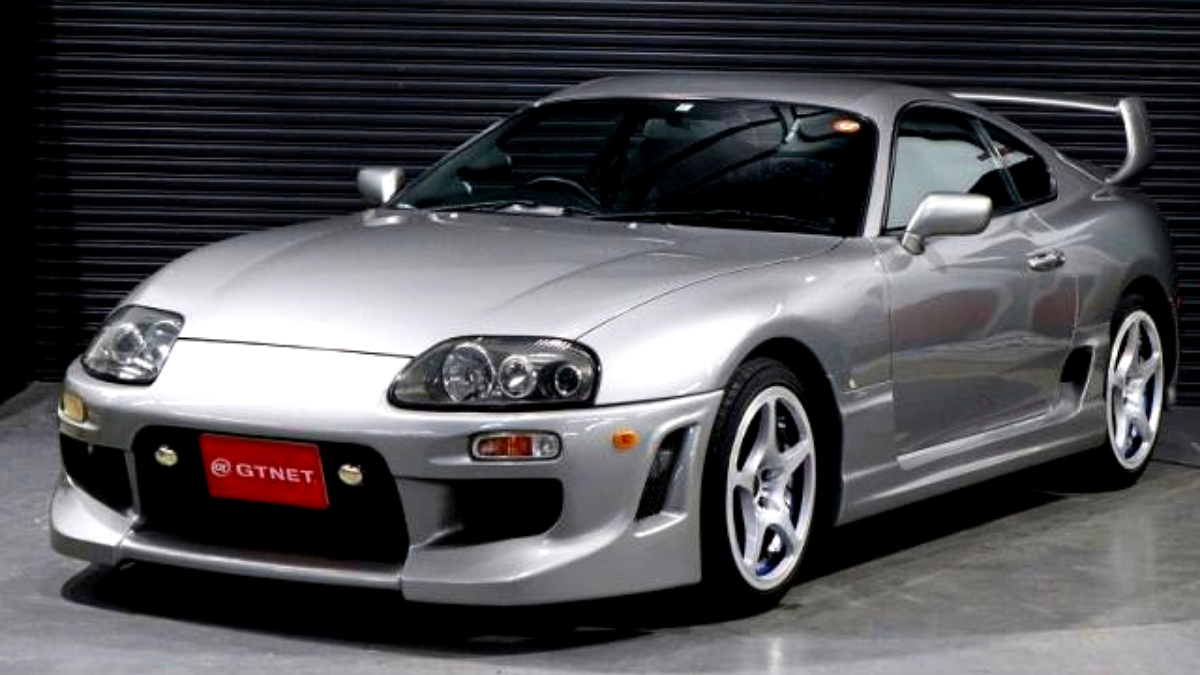Your cart is currently empty!

1993 – 2002 Toyota Supra Mk4: Review And Buying Gude
The Toyota Supra Mk4 stands out in the renowned Supra family. There’s a reason why the Mark 4 is commonly known as the best of the bunch. It combined the best features of the JDM. Built between 1993 and 2002, the Toyota Supra MkIV came with two engine options; a 220-horsepower naturally aspirated 2JZ-GE 3.0-liter inline-6, and a 280-horsepower 2JZ-GTE 3.0-liter twin-turbocharged straight 6. Both engines were offered, and each model offered both automatic and manual options.
Today, the Supra Mk4 is among the most sought-after Toyota sports cars around the world, and for good reason. This is a buyer’s guide of the 1993 – 2002 Toyota Supra Mk4. My article talks about all the features, specs, and factors that made the Supra an awesome sports car, and how much you should expect to pay for it today.
History Of The Toyota Supra
The Toyota Supra originally emerged in 1978, but not as a fully-fledged model. At launch, the Supra was only available as a mere trim level. It wasn’t until it underwent about four generations that the JDM became its model. It was during the 1993 to 2002 period when the Toyota Supra stood out in the industry, with the Supra Mk4 version standing out as a true marvel of engineering prowess.
During this 1993 to 2002 period, Toyota offered the Supra model with a plethora of customizable options. There were several turbocharged engines of the Supra available. Buyers could also choose between a manual or automatic transmission. On top of that – quite literally, Toyota offered a sports roof variant. With all these options, the Supra became synonymous with personalized driving experiences. Every model was unique. That’s why it’s hard collectibles with similar powertrains or other configurations.
Above all these aspects, the Toyota Supra stood out (I guess it still does) for being an awesome investment. But what exactly accounts for the timeless allure possessed by this particular model? Is it the awe-inspiring straight-six engine or perhaps the increasingly rare analog driving experience it offers amidst our digital age?
Toyota Supra Mk4 Price
The price of the Toyota Supra depends on three things: on your choice of turbo or naturally aspirated, automatic or manual transmission, and choosing between a hardtop or sports roof. Between 1993 and 2002, a Mark 4 Toyota Supra would cost around $40,000. The price of the Supra Mark 4 has gone up over the years. Today, you should expect to pay up to $100,000 for a 1993 – 2002 Toyota Supra Mark 4, according to classic.com.
Toyota Supra Mk4 Review: Driving Impressions
Even though the Mark 4 Toyota Supra is over 20 years old, it’s still competitive today. The Supra Mark 4 still makes a compelling choice today. Behind the wheel, the Mark 4 offers an exceptional performance.
The Toyota Supra has sequential compressors, which allow for easy boosting of the low RPM via the brake pedal to pressurize the intake.
The steering on the Supra Mark 4 feels light and well-weighted, perfect for holding a drift. While the Supra horsepower of 321 hp feels low by today’s standards, the actual engine output was higher.
Toyota Supra Mk4 Specs
The best engine in the Toyota Supra is the 2JZ-GTE, This engine is so powerful and reliable that it has been swapped into almost every model. This Toyota Supra 2JZ-GTE engine produces 321 horsepower and 315 lb-ft of torque.
With the 2JZ-GTE engine, the Toyota Supra Mk4 achieved a top speed of 177 mph, but it was limited to 155 mph outside of Japan. The TSupra Mk4 has the efficiency of sequential turbochargers, which allow the car to sprint to 60 mph in 4.7 seconds from a standstill. This makes the Toyota Supra quicker than most V8-powered sports cars.
| 1993 – 2002 Toyota Supra Mark 4 Feature | Specs |
| Toyota Supra Mk4 Price | $40,000 (at launch) |
| Engine | 3.0-liter Sequential Turbo Straight Six |
| Transmission System Options | 6-Speed Manual, or 4-Speed Automatic |
| Horsepower | 321 horsepower |
| Torque | 315 pound-feet |
| 0 – 60 mph acceleration | 4.7 seconds |
| ¼ mile sprint acceleration | 13.1 seconds @109 mph |
| Top Speed | 177 mph |
Toyota Supra Mk4 Engine
The old 90s Supras are commonly loved for having the best inline-6 engines ever made. Why? Because it is capable of up to 1,500 horsepower. The Supra’s inline-6 engine is also one of the best-designed sports car engines out there.
The design of the inline-6 engine in the Supra starts from the cast-iron block with 7 main bearings. An aluminum head has dual cams and four valves per cylinder. One disadvantage is the Mark 4 Supra is the use of an external timing belt instead of a chain, but replacement is not much of a headache. Variable timing for the intake cam arrived in 1997, increasing the efficiency at all RPMs.
Toyota Supra Mk4 Transmission
As I mentioned earlier, the Toyota Supra was available with a plethora of features, including transmissions. The base Supra version had a 4-speed automatic. Toyota partnered with Getrag to give the Supra a manual transmission. In the end, the manual transmission Toyota Supra sold more than the automatic transmission versions. The manual variant was also more popular as it was more engaging to drive. Because the automatic transmission Supra was less popular, it was harder to find replacement parts for it, especially for the auto transmission components. So, if you are going to get your hands on a Supra, get the manual.
Toyota Supra Mk4 Interior
Once you step inside the Supra, you will immediately know that you are inside a 90s car. It’s the styling that gives it away, but not in a bad way. What I noticed, personally, is that the front cabin is driver-focussed. Everything on the dashboard and console points towards the driver, even in the cockpit. And speaking of. All the gauges and readings are notably easy to read, even when you’re sitting in the rear seat. Also available in the rear seat is a lot of legroom and headroom. The Supra was, after all, a passenger sports car.
Unlike the rest of the Supra family, the Mark 4 Supra is distinctly notable for its double-DIN head unit radio, which has room for upgrades.
Mk4 Supra Production Numbers
Naturally-Aspirated Automatic Supra (Sport Roof): 1306
Naturally-Aspirated Five-Speed Supra (Sport Roof): 1429
Naturally-Aspirated SE Automatic Supra (Hardtop): 412
Naturally-Aspirated SE Automatic Supra (Hardtop): 592
Naturally-Aspirated Automatic Supra (Hardtop): 274
Naturally-Aspirated Five-Speed Supra (Hardtop): 249
Six-Speed Supra Turbo(Hardtop): 326
Six-Speed Supra Turbo(Sport Roof): 3712
Automatic Turbo (Sport Roof): 2939
Toyota Supra Brakes
Toyota Supra brakes are awesome, as are many sports cars from the 90s. While the base Supra version had 11.6″ front rotors, the Turbo Supra variants used 12.7″ on the front. Toyota Engineers added the first true stability system in the Toyota Supra Mk4. What most people don’t know is that the Toyota Supra is the first production car with a 4-channel ABS. Before that, this technology was only available on their F1 teams. In the Toyota Supra Mk4, the ABS tech was tuned to allow maximum cornering. The ABS also gave the Supra a great drifting angle by pulling the car back when a drift began.
Best Features Of The Supra
While the Toyota Supra was ahead of its time (technology-wise), it still used some old tech that worked for it. The best feature of the Toyota Supra is the mechanical cooling fan. The Supra was the last passenger car with this type of cooling fan. Other top features of the Supra sports car, particularly my favorite Mk4, are the front cross member, Targa roof, upper control arms, and aluminum hood. Thanks to these awesome features, the Toyota Supra Mk4 remains a top-priced collectible sports car.
The Time When The Toyota Supra Made A Glorious Return
After a two-decade hiatus, the Toyota Supra came out in 2019. Even though there was a lot of hype upon release, hardcore Supra fans were disappointed, especially folks who loved the fourth-generation model.
The 2019 Toyota Supra was a letdown because the sports car had a BMW-sourced engine, and not the Toyota 2JZ as everyone expected. To build the Supra Mk5, Toyota collaborated with BMW, hence the BMW-sourced engine.
2020 Supra Review And Features
Moving on to the 2020 model year, the Toyota Supra became more advanced in various ways. For starters, the newer Supra versions had advanced turbo technology setups that enabled the complex sequential setup to be replaced by a single turbocharger. If you’re looking for good twin turbos for your Toyota Supra, you can find lots of good options on eBay. I recommend this option.
Most users find it simple to modify their Supra with twin turbos, though. Unlike the original setup, the Variable geometry and dual scroll turbines adapt more quickly. With a few Toyota Supra modifications, it is easy to make 600 to 800 horsepower. You could achieve this souped-up power by modifying the Toyota Supra’s air system. However, modifying your air or fuel system greatly affects fuel economy.
Fuel Economy
In terms of fuel economy, the Toyota Supra achieves 24 MPG on the highway, which reaches up to 30 MPG with a nice intake and exhaust upgrade.
Author Details

Our Team
Hi there! Welcome to Flagship Drive.
I’m Wilfred Nkhwazi, a passionate car lover from Africa. I created this platform to share expert insights, honest reviews, and a fresh perspective on the latest cars and automotive trends. Let’s hit the road together.
Advertisement

Recent News

